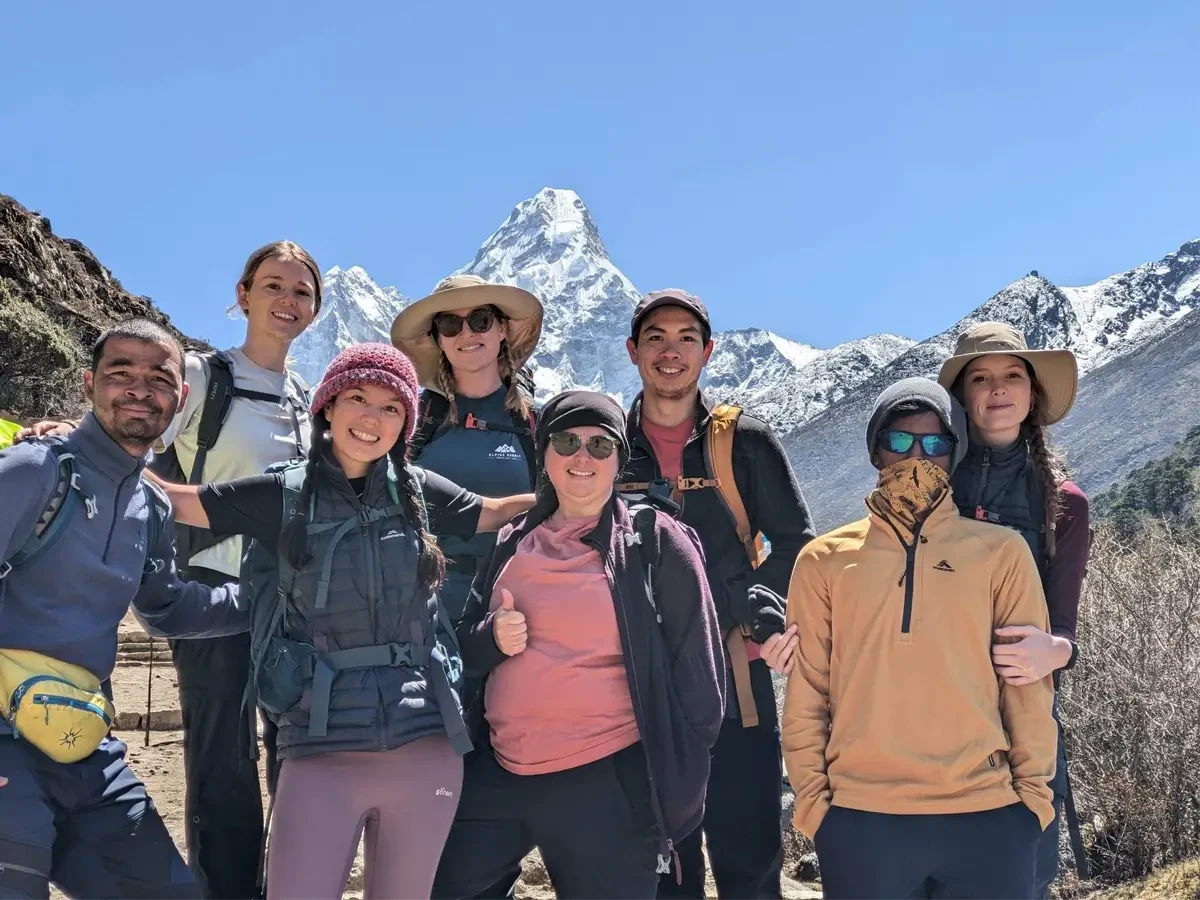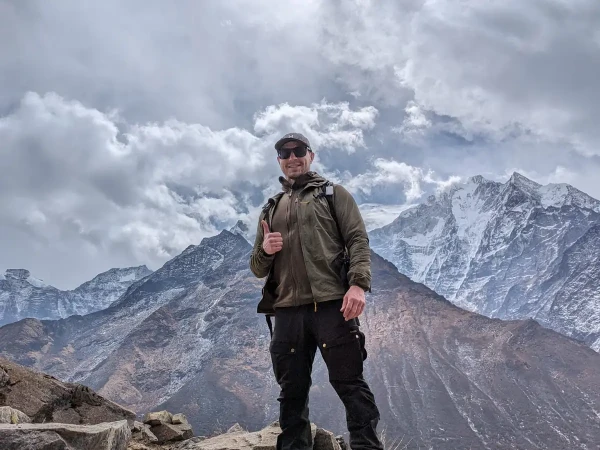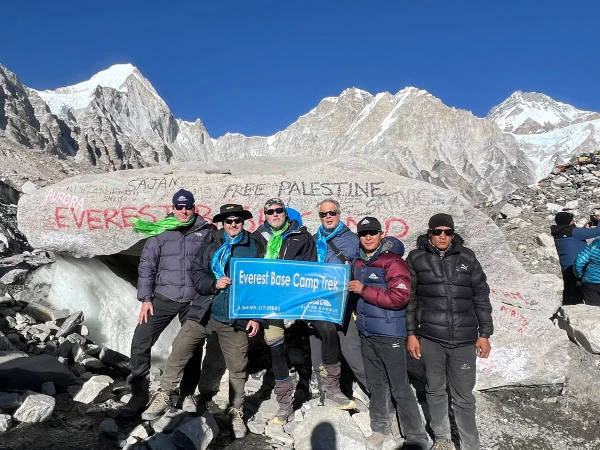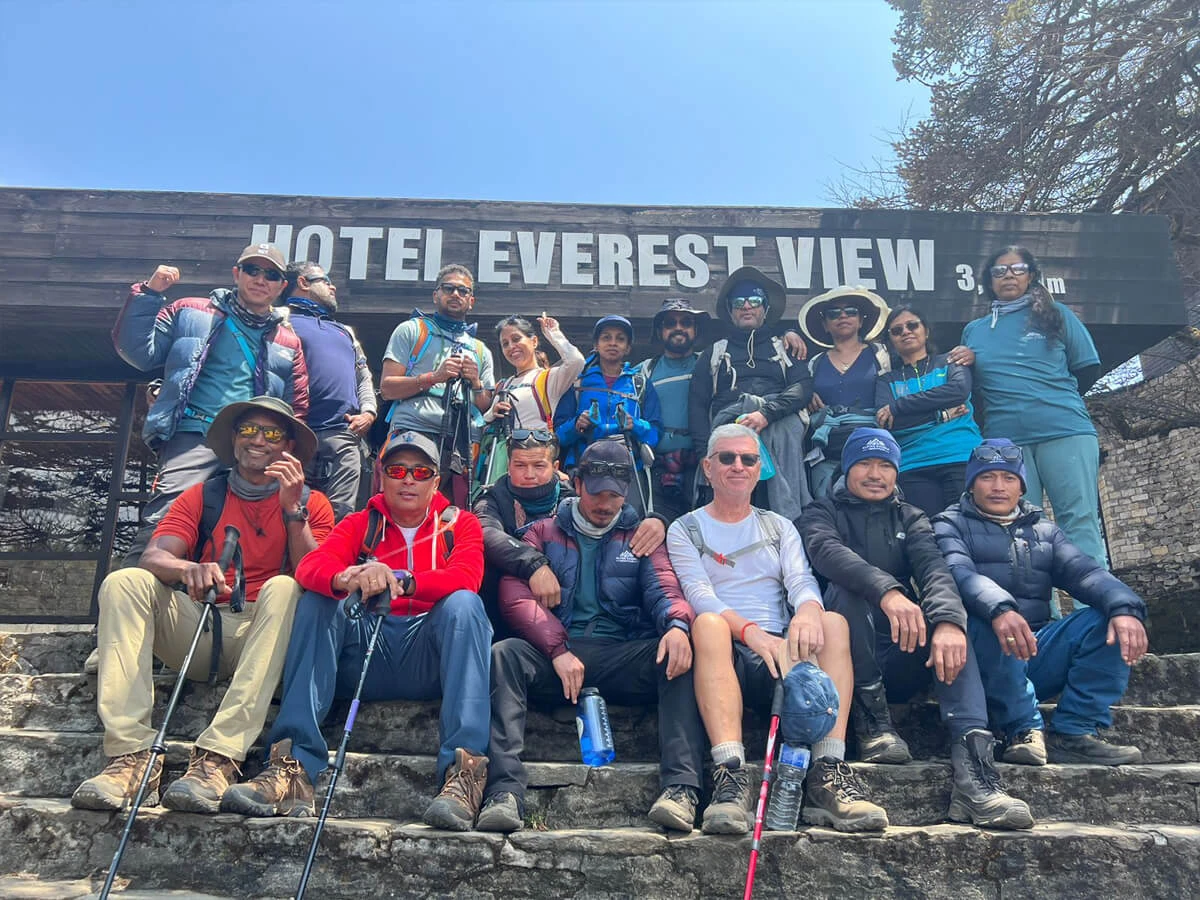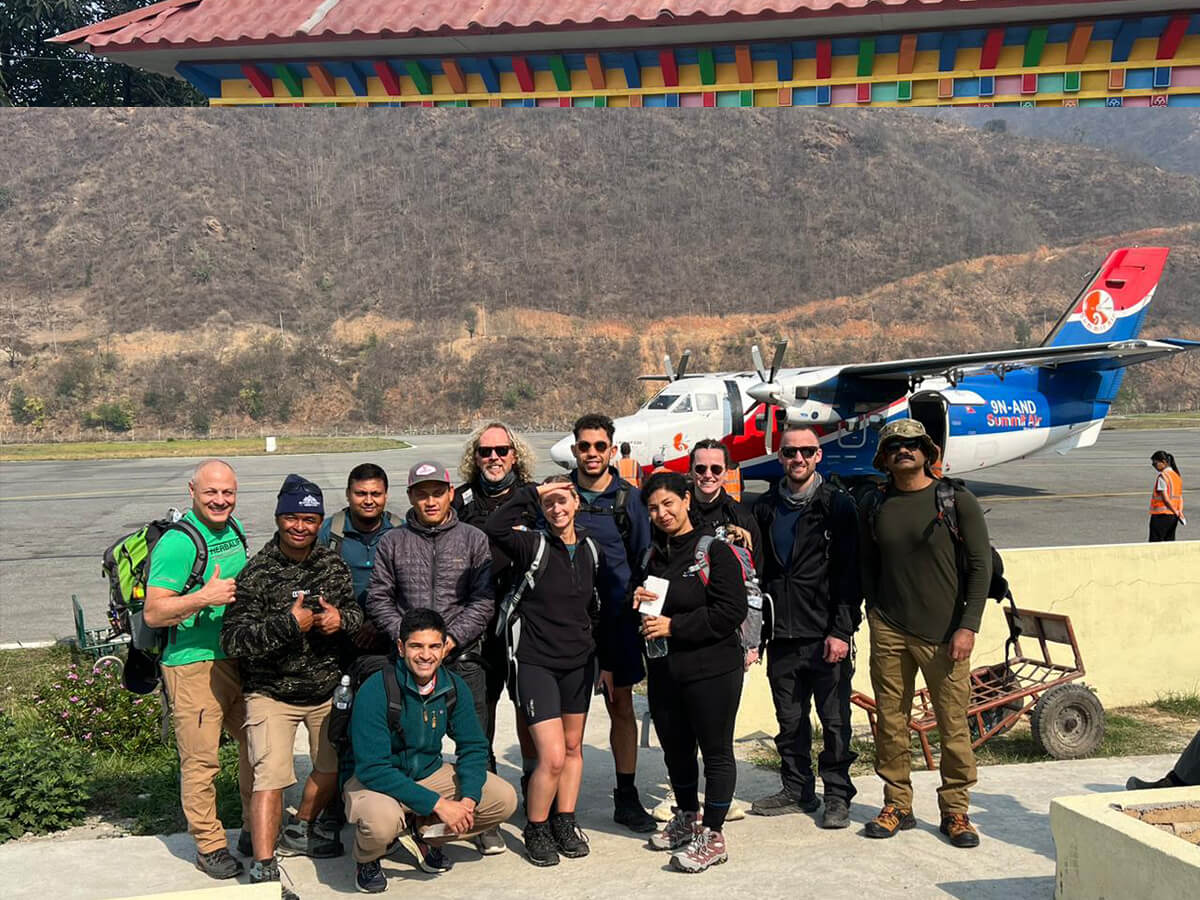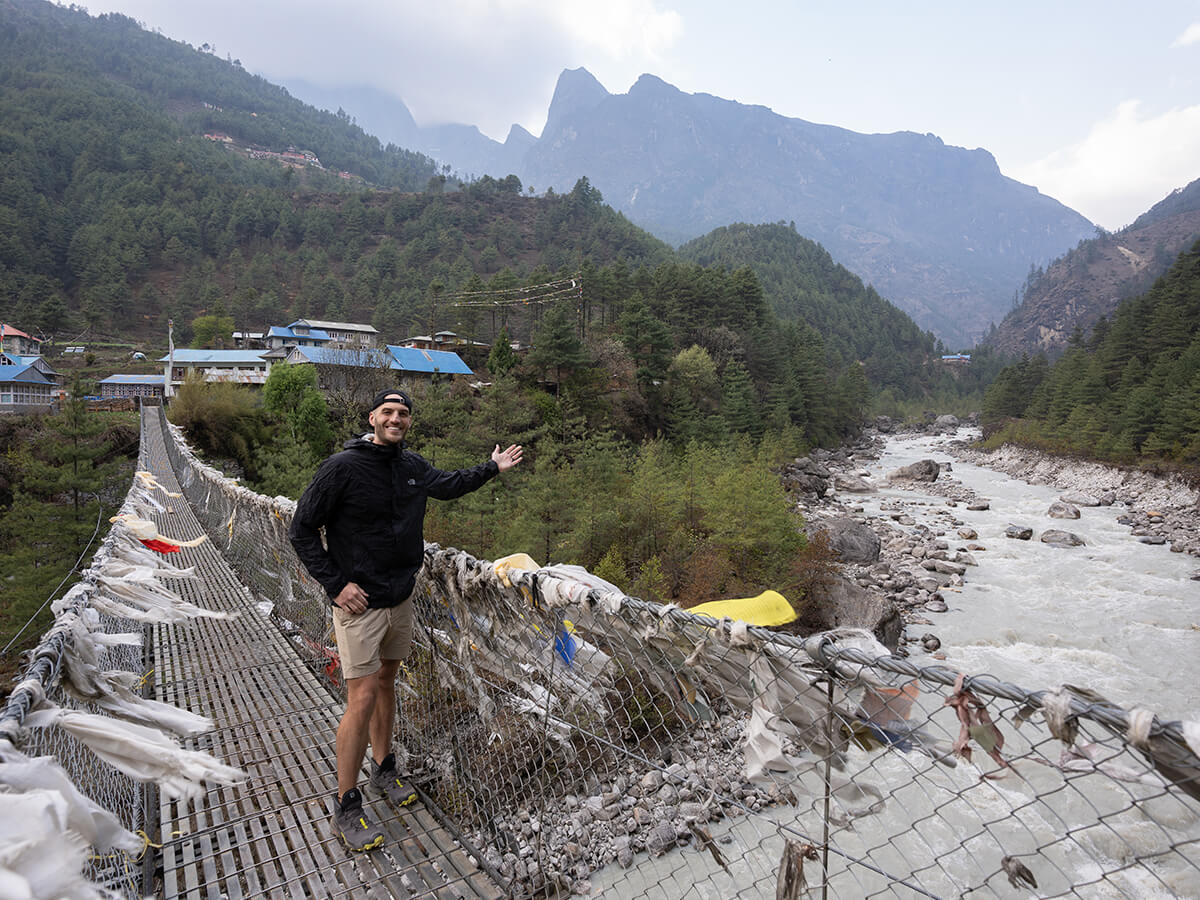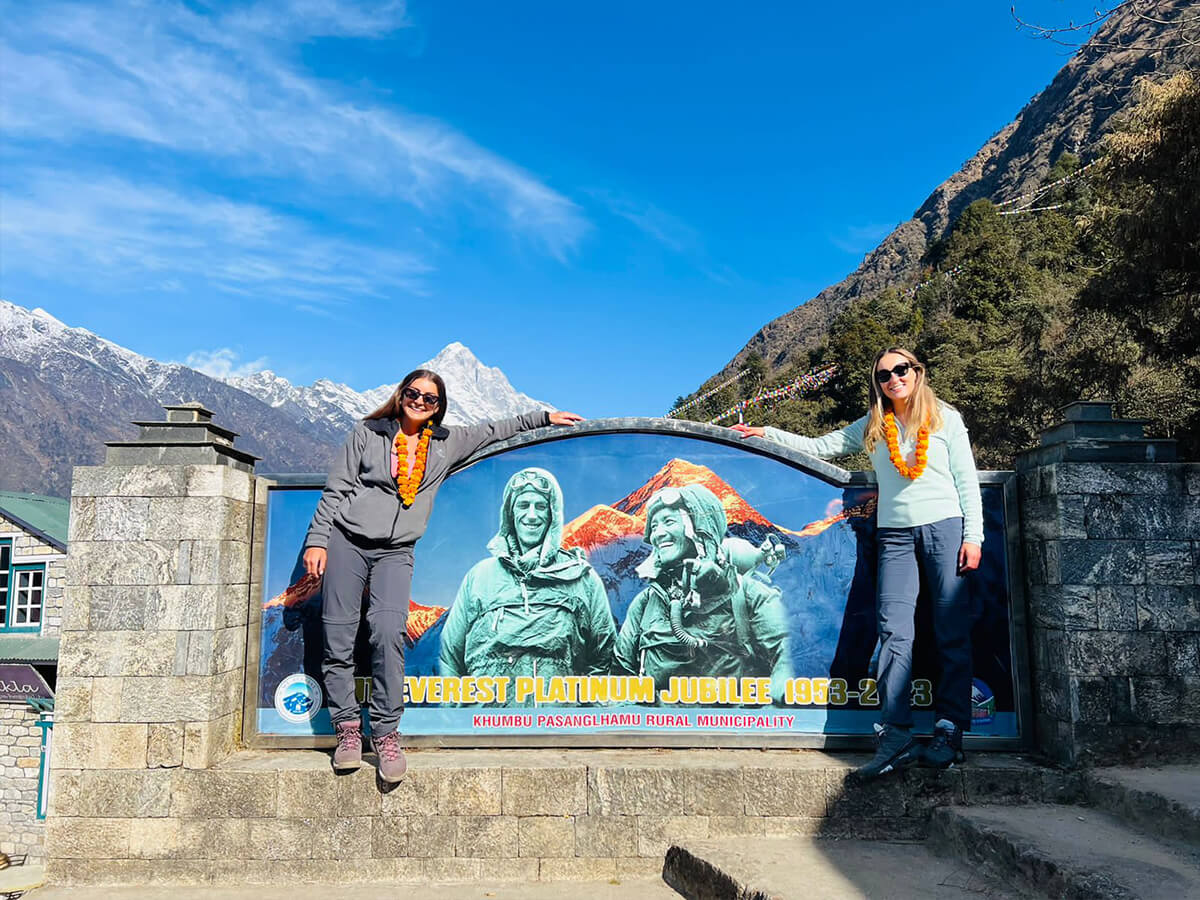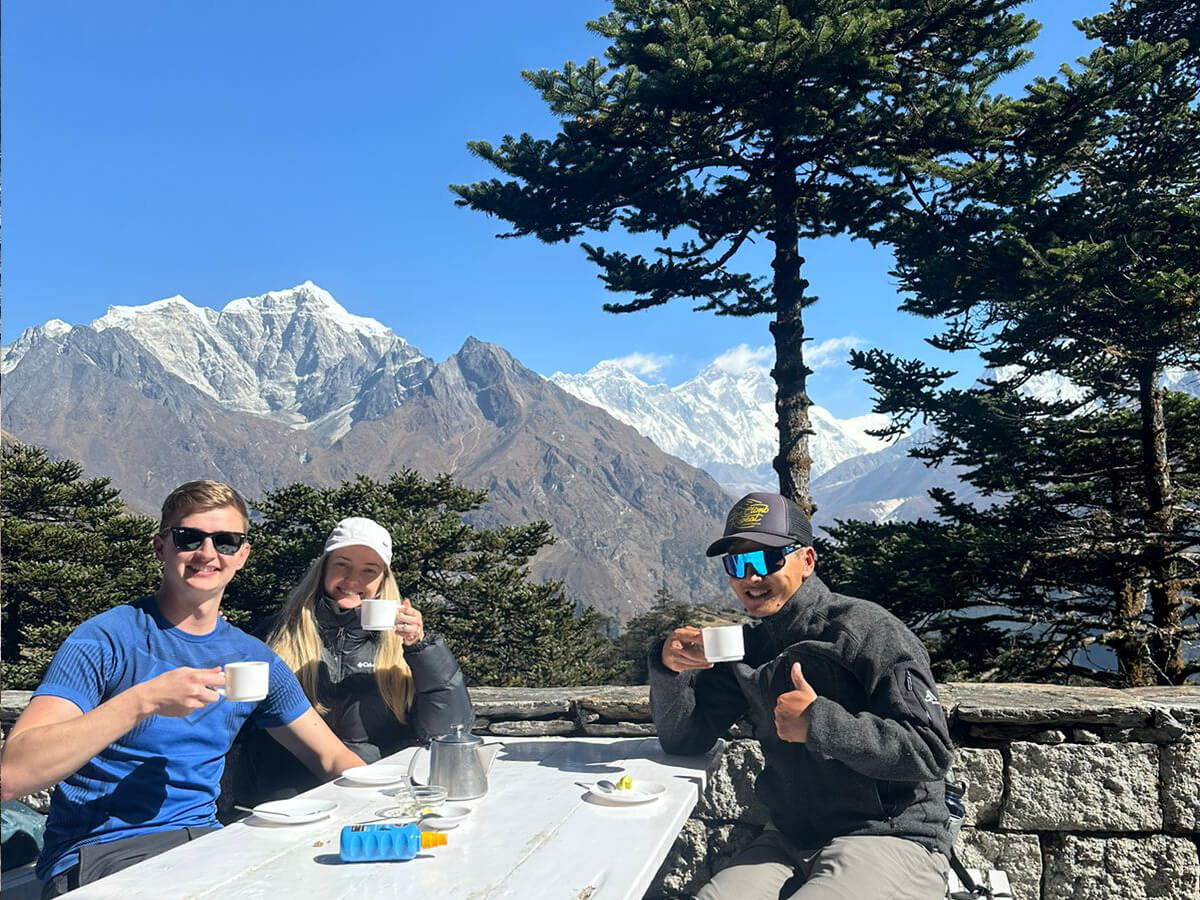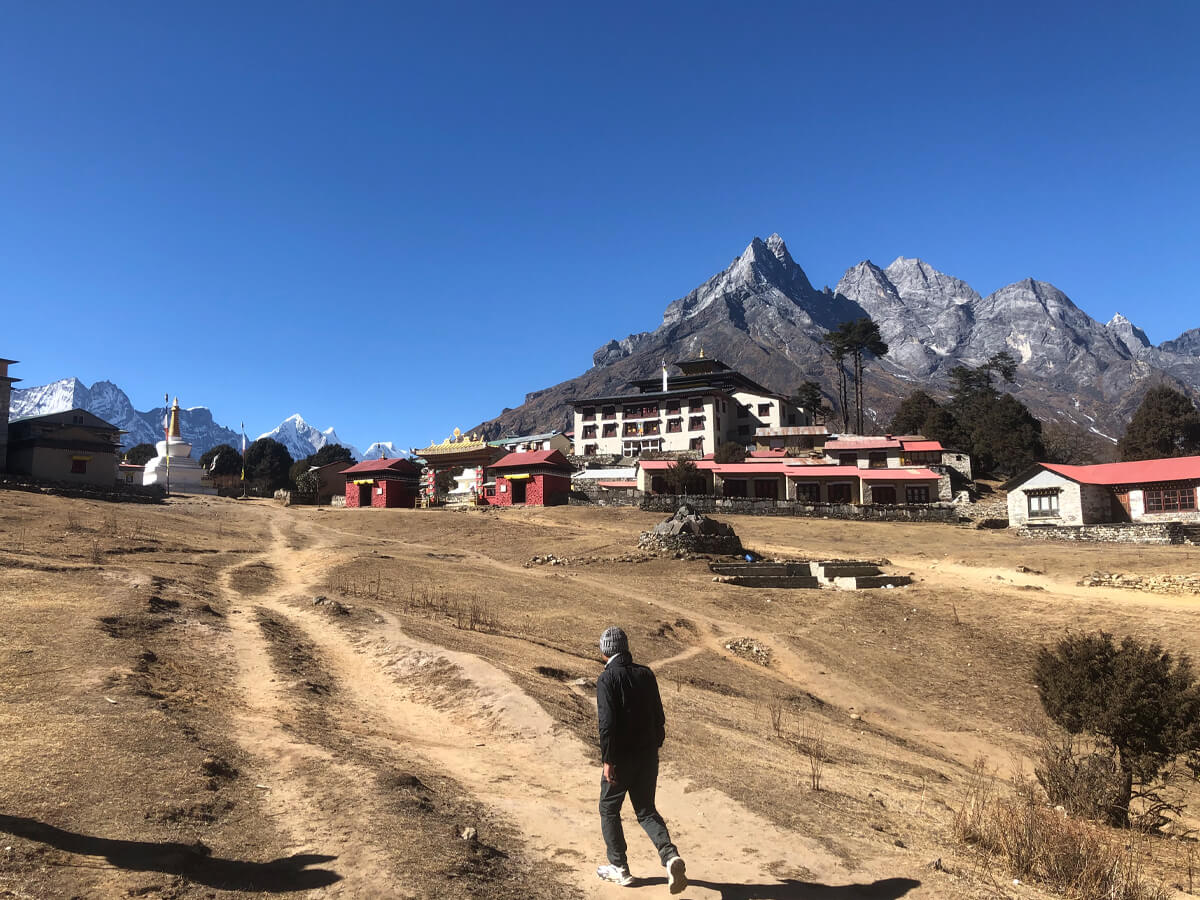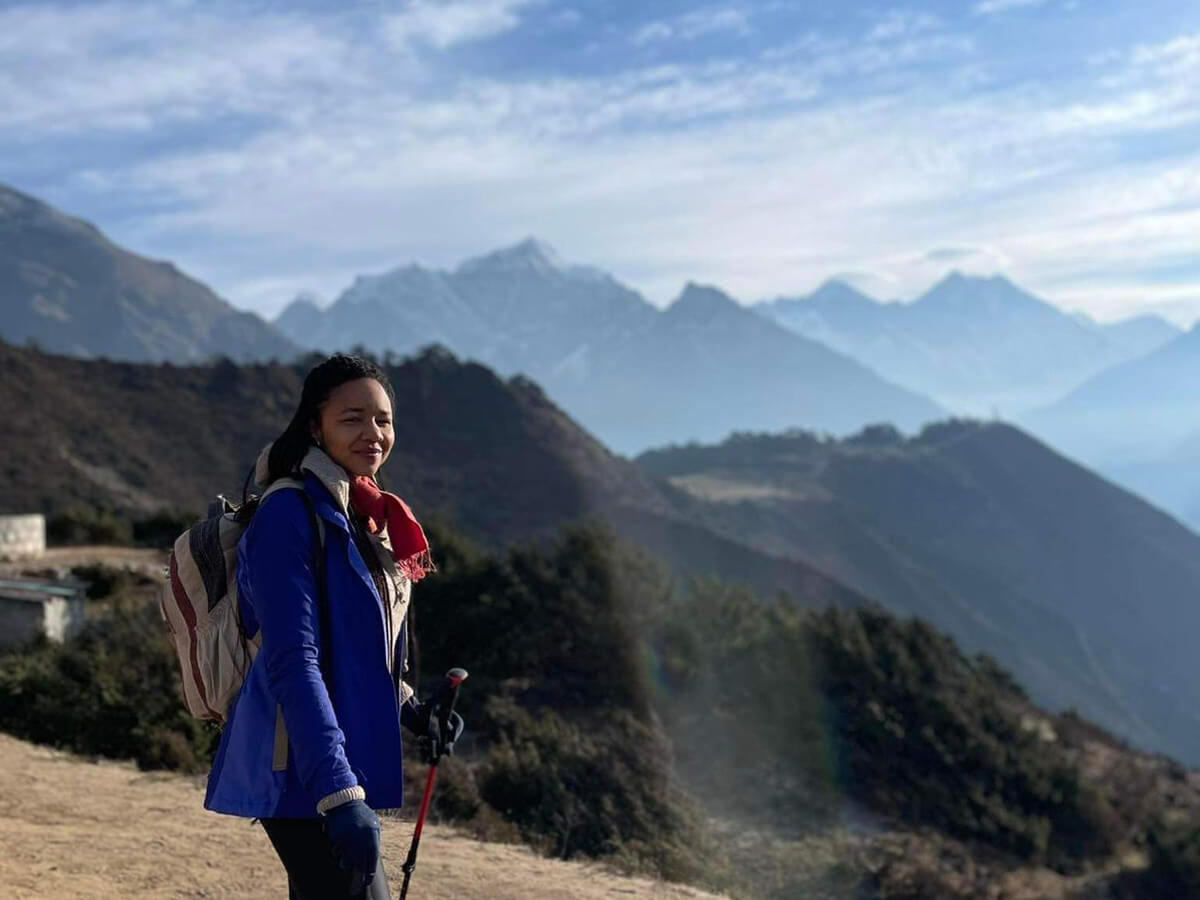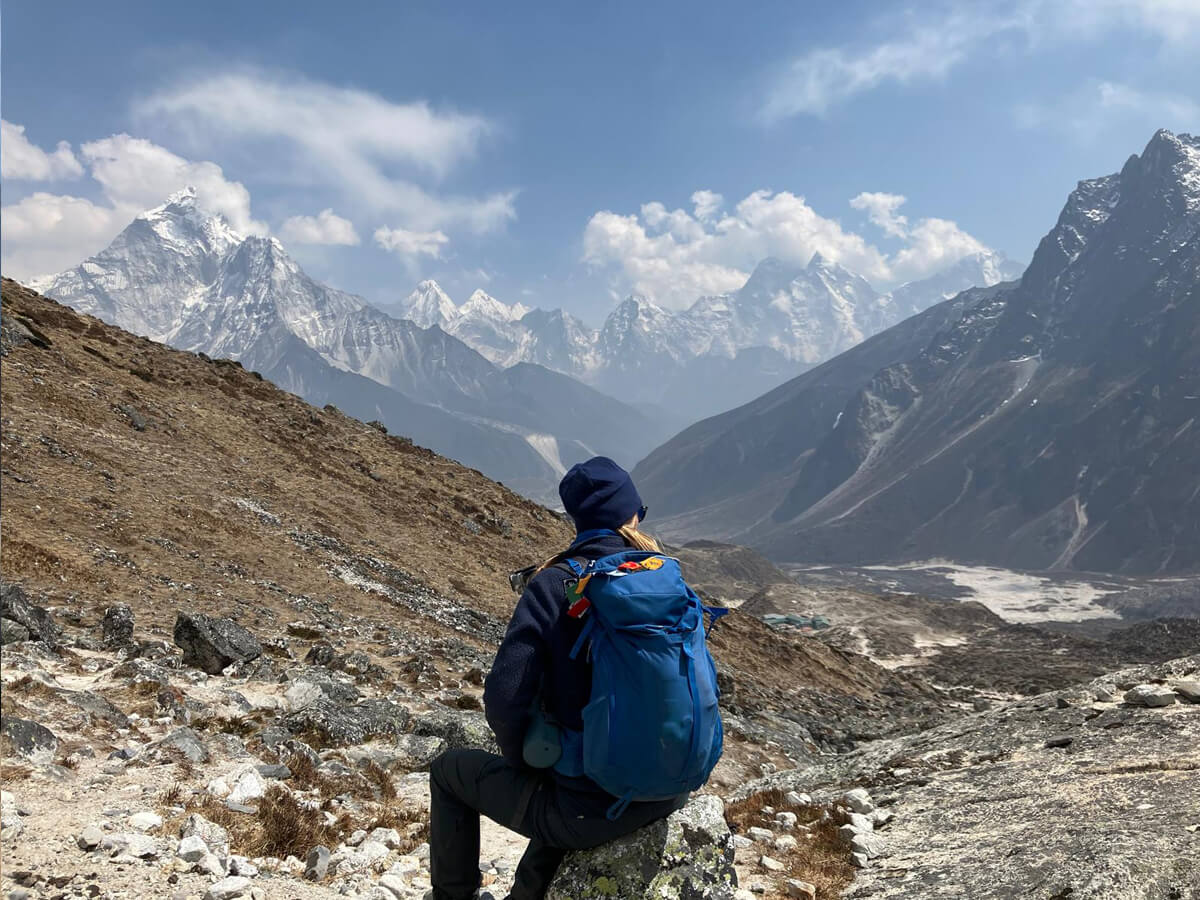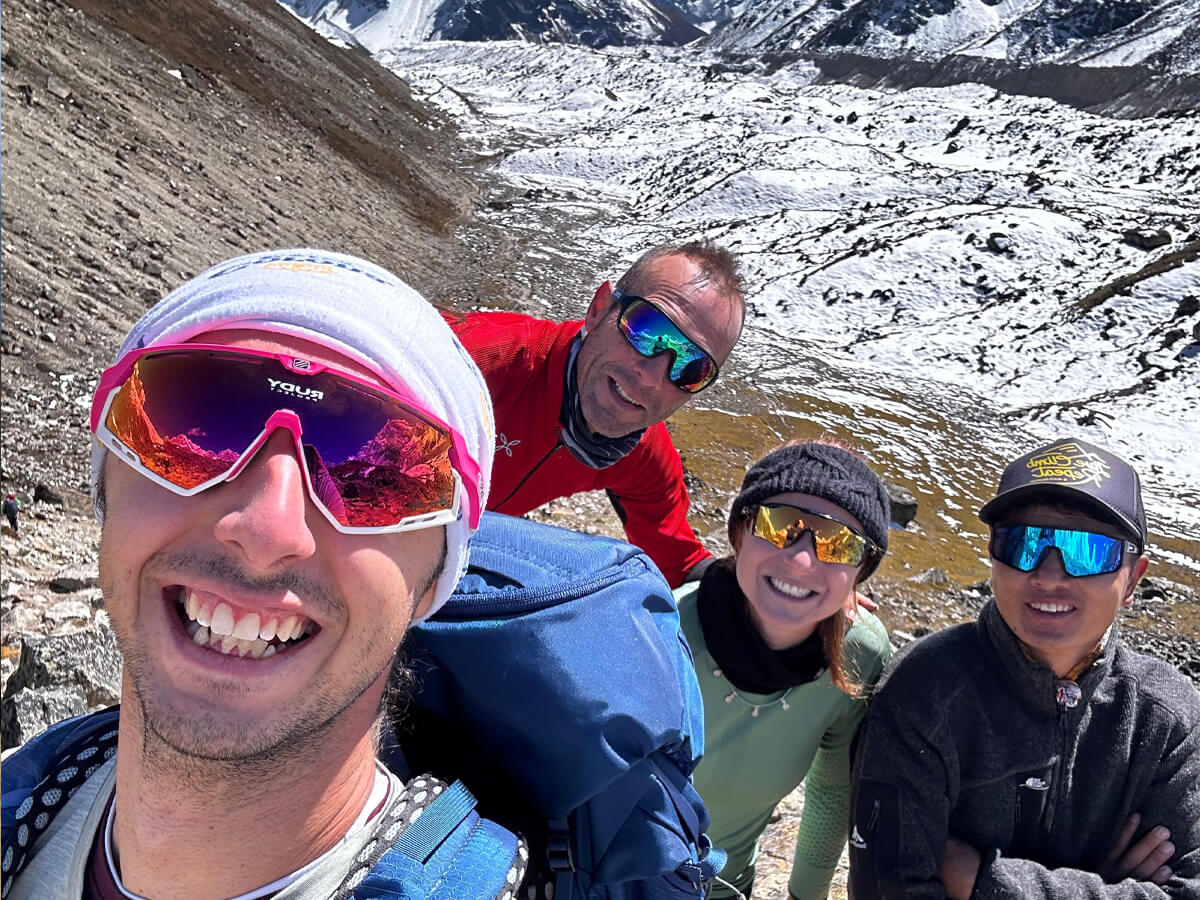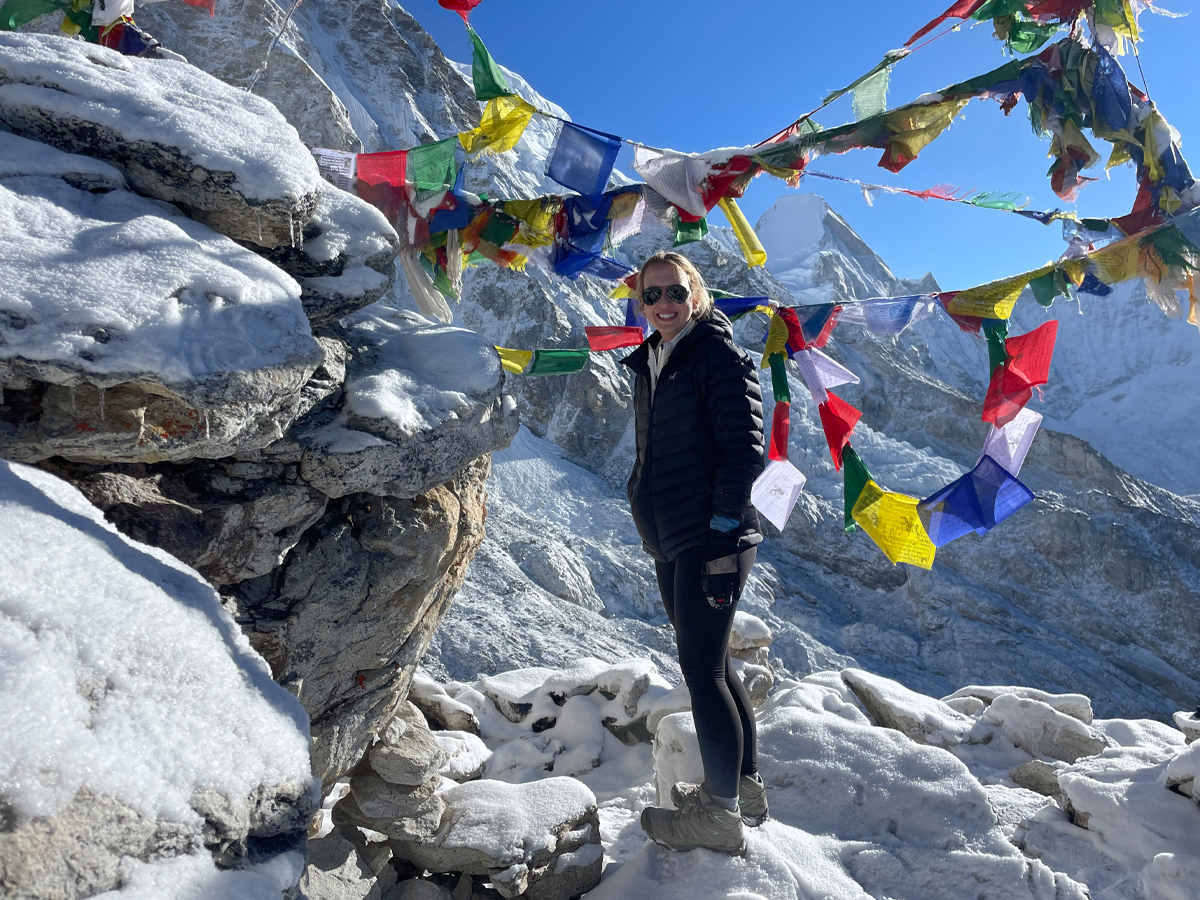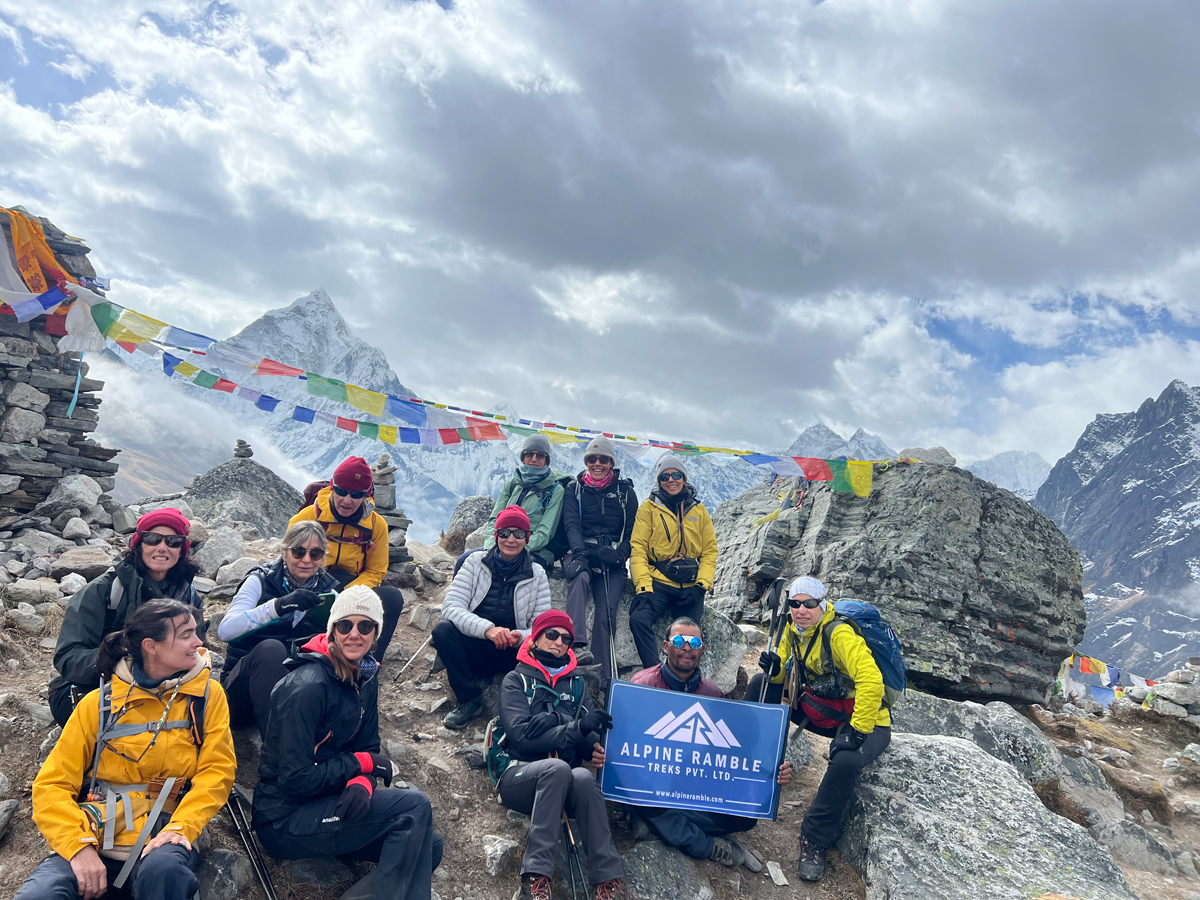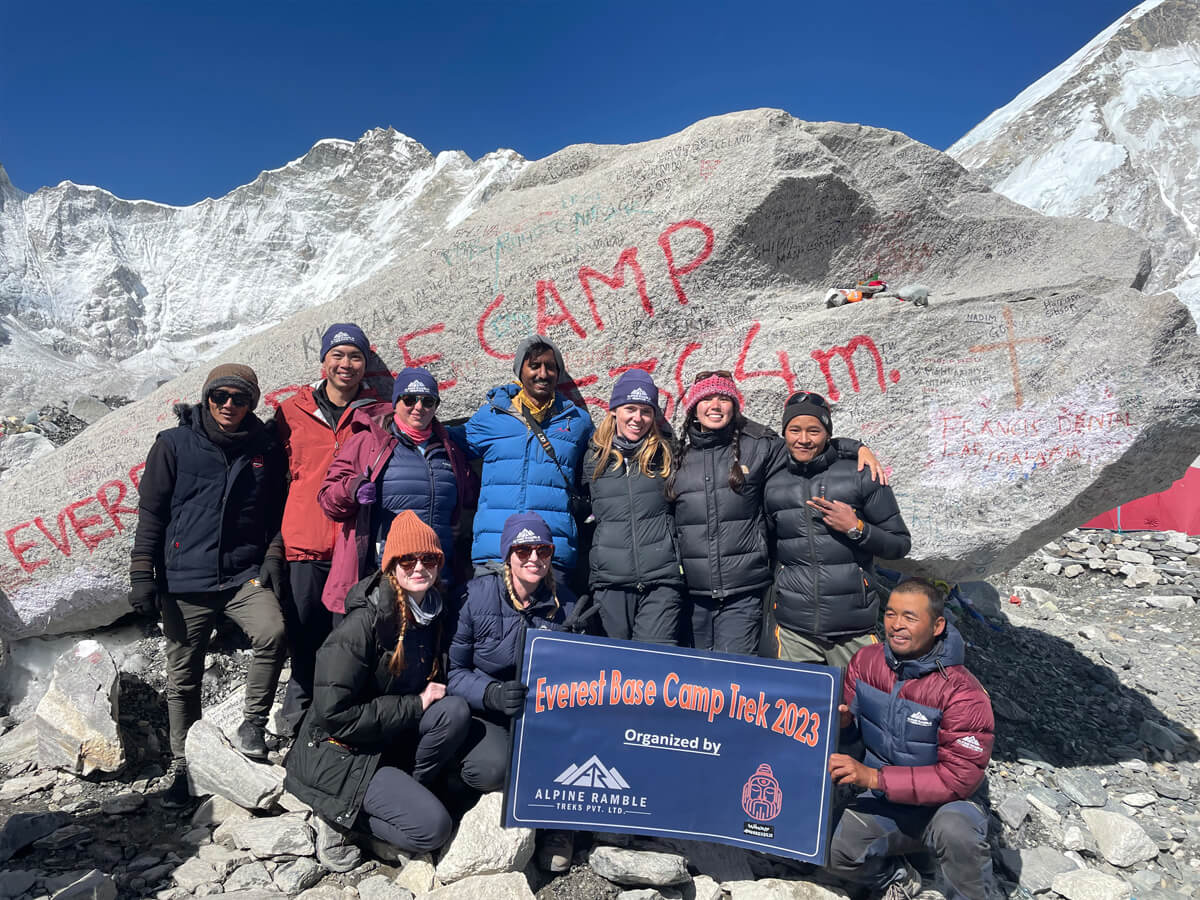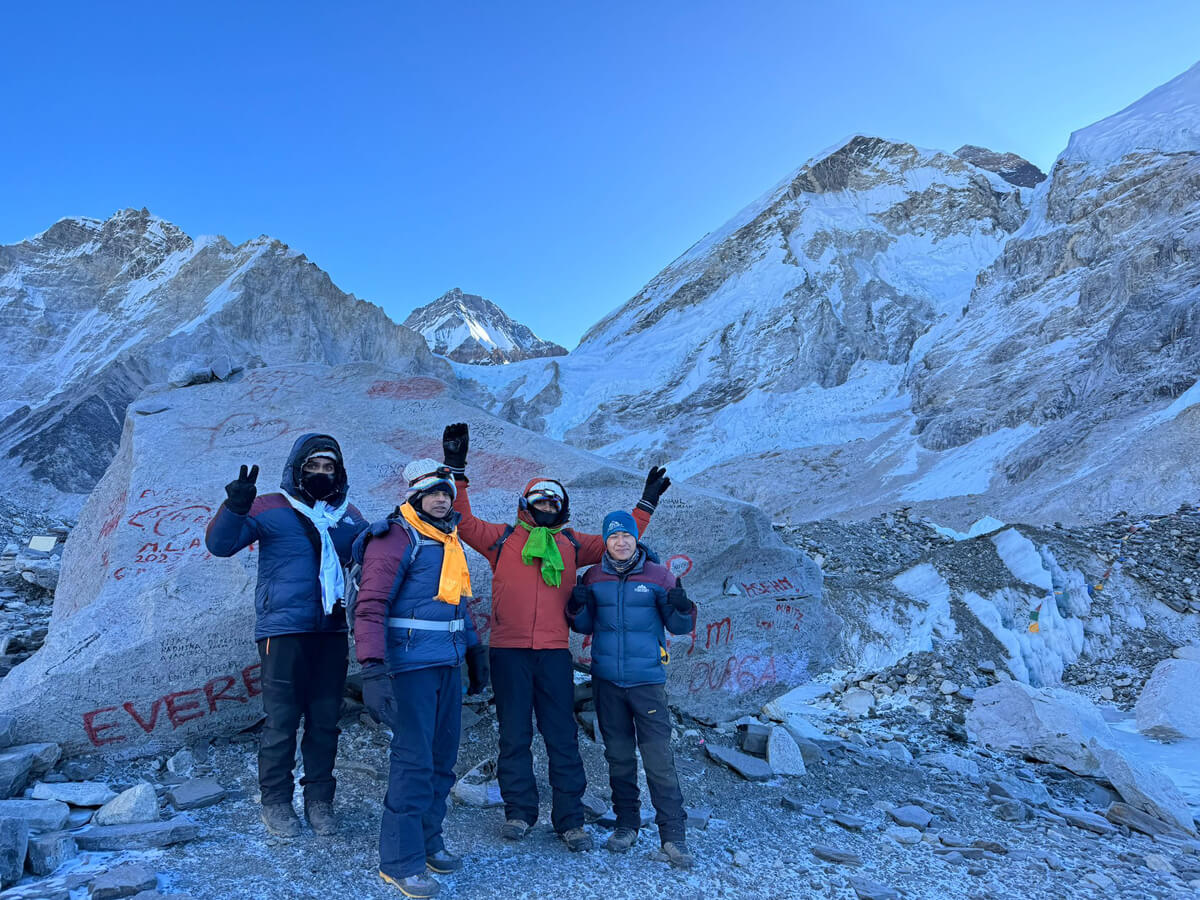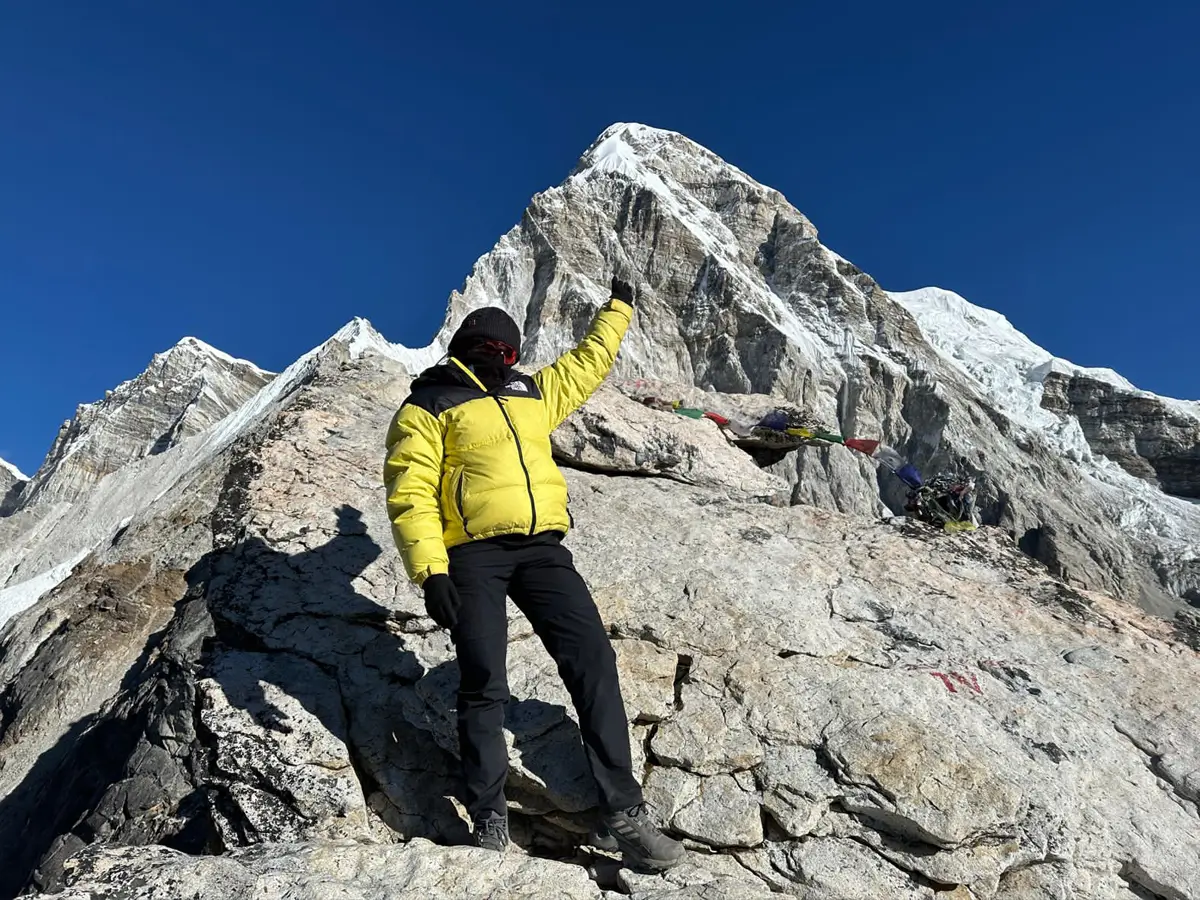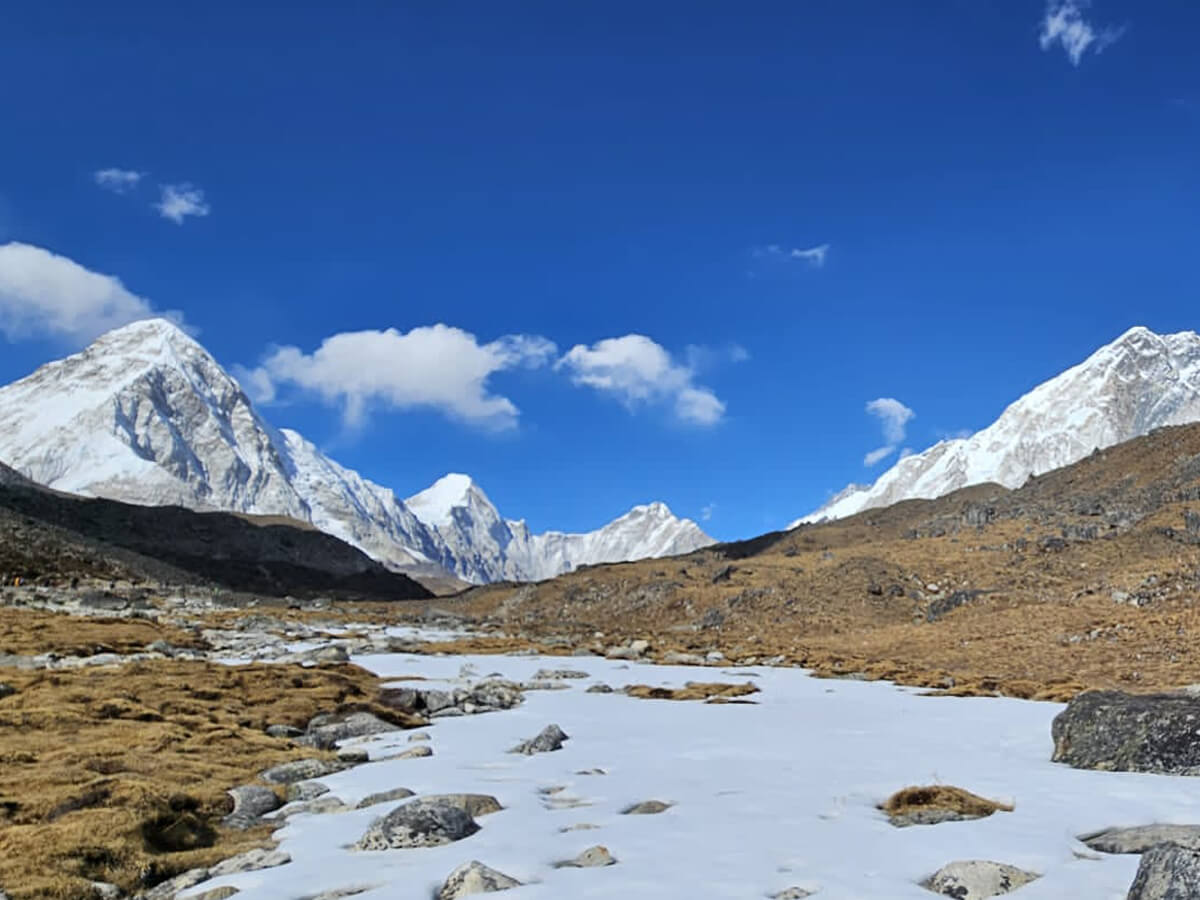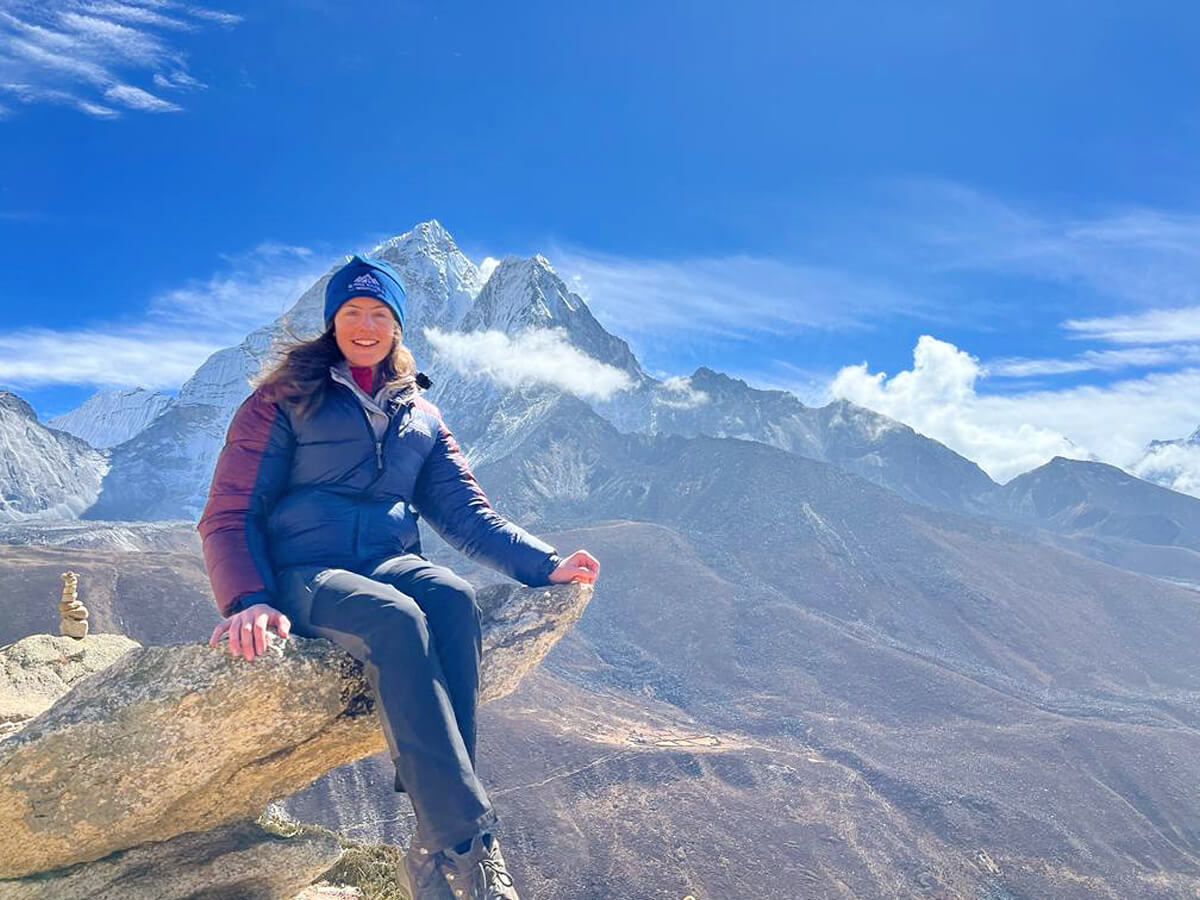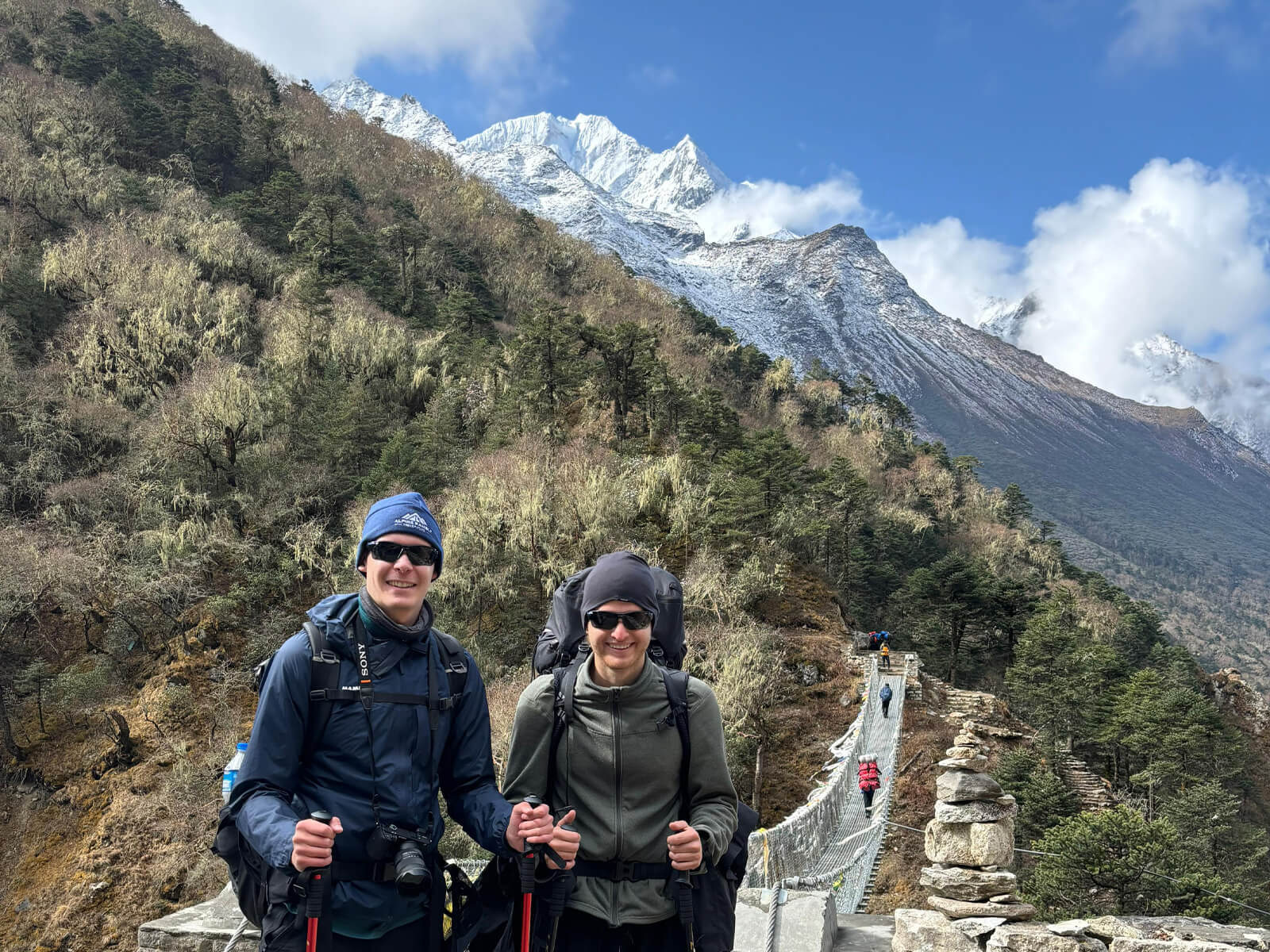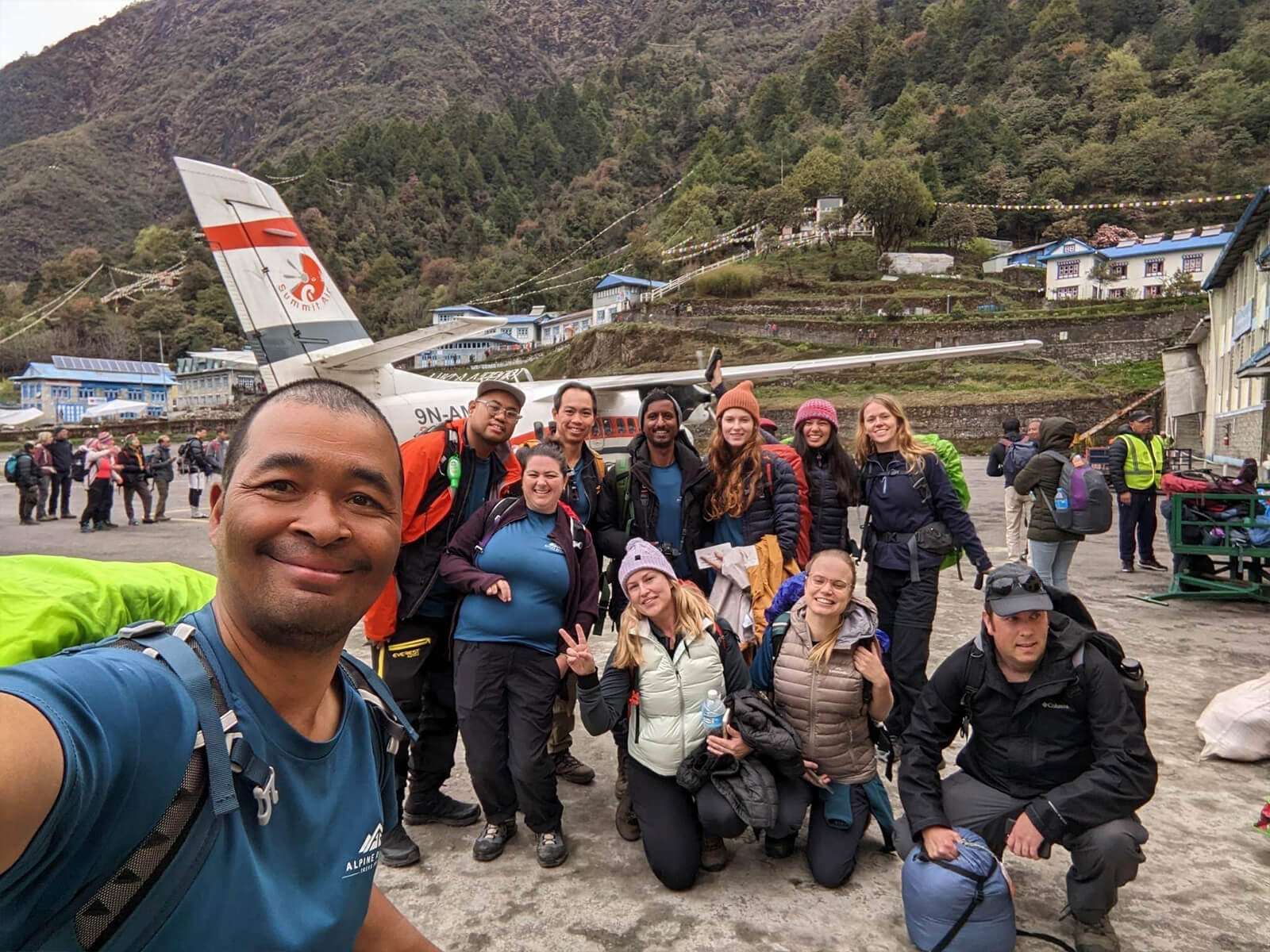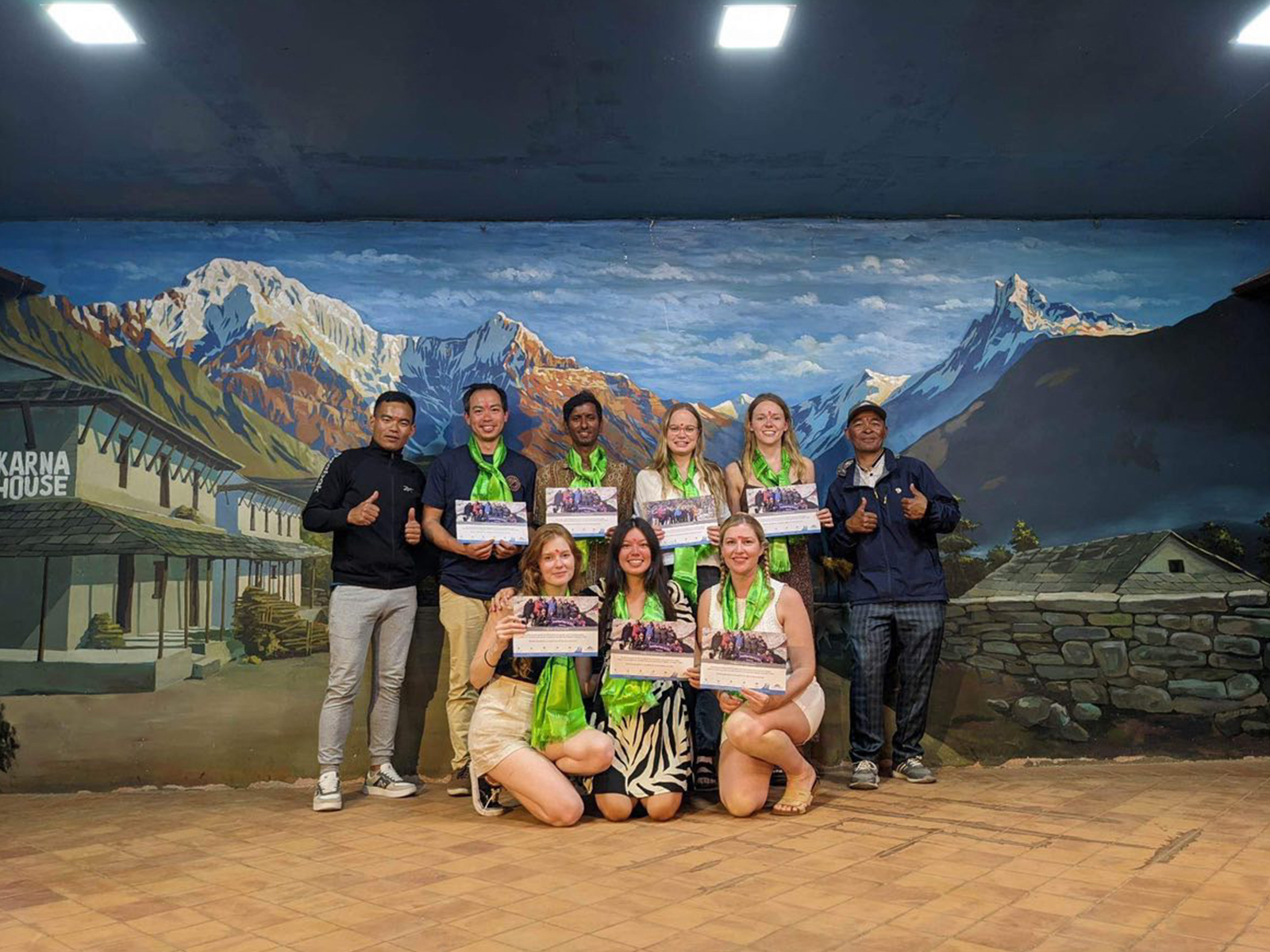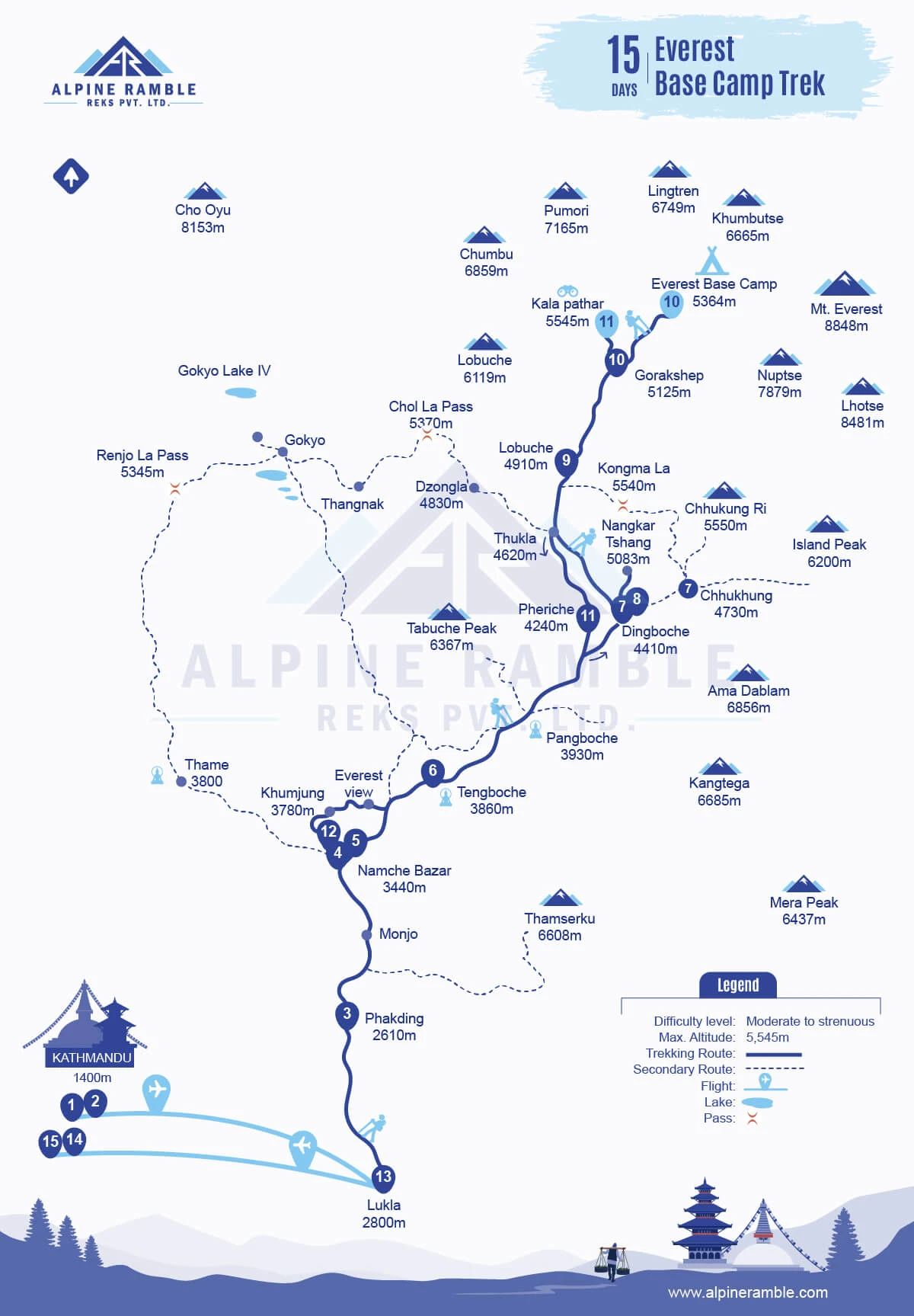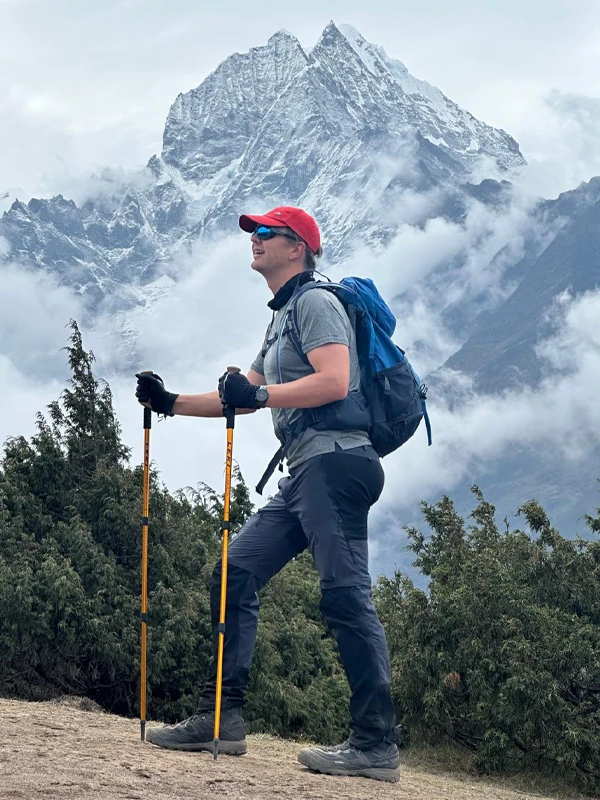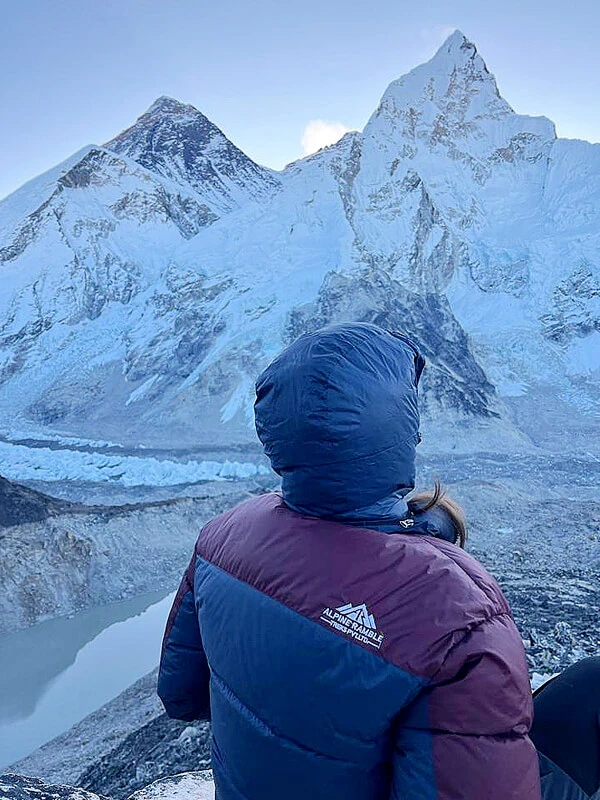If Everest Base Camp trek is on your bucket list, you deserve to do it with guides who know these trails like home.
With over 20 years of guiding experience, Alpine Ramble brings you closer to the Sherpa culture through deep-rooted ties in the Everest region. Our community of 15,000+ trekkers and 100% trek completion rate speak to the care and expertise we bring to every journey.
Over 14 days in your everest base camp trip, you’ll pass through Namche Bazaar, Tengboche, and Dingboche, before reaching the legendary Everest Base Camp at 5,364 meters. This isn’t just a trek; t’s the chance to safely live a story that will stay with you forever.
Everest Base Camp Tour Highlights
- Fly into Lukla, the World’s Most Thrilling Airstrip: Start your journey with the legendary Lukla flight, an adventure in itself. With Alpine Ramble’s 20+ years of local insight, even this adrenaline rush feels smooth, safe, and unforgettable.
- Namche Bazaar: Where Sherpa Culture Meets Comfort: Discover the Himalayan capital guided by locals who grew up here. Beyond cafés and markets, Alpine Ramble connects you to hidden corners and stories most trekkers pass by.
- Cross the Iconic Hillary Suspension Bridge: Step onto prayer-flag-draped bridges that sway high above the Dudh Koshi River. With our pacing, you savor the thrill without the rush, turning fear into freedom, and adrenaline into awe.
- Authentic Sherpa Life Along the Trail: Walk with guides who belong to the Khumbu. This isn’t staged culture, it’s genuine connection, shared tea, and deep community ties that turn the trail into a living classroom of Sherpa heritage.
- Tengboche Monastery: Spiritual Heart of the Khumbu: Experience morning chants echoing through the Himalayas at Tengboche. With Alpine Ramble’s long-standing ties, you step in with respect and context, not as a tourist, but as a welcomed guest.
- Sagarmatha National Park: A Living World Heritage: Trek through forests, glaciers, and wildlife inside a UNESCO site. Every step reveals contrasts; rare Himalayan flora, elusive wildlife, and geology explained by guides who’ve spent decades walking these very paths.
- Hotel Everest View & Syangboche Airstrip: Sip coffee at the world’s highest hotel and visit Syangboche’s plateau airstrip. Few treks offer this rare mix of luxury, altitude history, and sweeping Everest panoramas, all in one trail.
- First-Row Everest Panoramas: Stand at viewpoints where Everest, Nuptse, Lhotse, and Ama Dablam dominate the skyline together. This unique cluster of Himalayan giants is visible only in the Khumbu, and Alpine Ramble ensures you see it at its best.
- Everest Base Camp: Legendary Milestone: Arrive at 5,364 m, where expeditions launch to the summit. With Alpine Ramble’s 100% trek success record, your arrival isn’t just possible; it’s guaranteed to be safe, meaningful, and unforgettable.
- Kala Patthar Sunrise Finale: Climb to 5,545 m and watch Everest ignite in golden sunrise. Carefully timed by our Sherpa guides, it’s the most rewarding finale you’ll ever experience in the Himalayas.
Could This Be Your Everest Story?
The Everest Base Camp Tour isn’t only for mountaineers, it’s for anyone with determination, curiosity, and the willingness to walk steadily into the heart of the Himalayas. With the right pacing, acclimatization, and guidance, it’s a journey within reach.
Your adventure begins with the thrilling flight into Lukla, where our Himalyan & Sherpa-born guides, backed by 20+ years of experience, help you navigate the legendary cliffside runway with ease.
Soon after, suspension bridges draped in prayer flags carry you high above the Dudh Koshi River toward Namche Bazaar, the bustling Sherpa capital where culture, markets, and camaraderie converge.
From here, your path winds upward through pine forests and into Tengboche Monastery, where chants echo beneath the towering peak of Ama Dablam.
With Alpine Ramble’s 100% trek success record and 15,000+ past trekkers, you move forward confidently, through Dingboche’s acclimatization stop, along the icy Khumbu Glacier, and toward your long-awaited goal.
At 5,364 meters, you stand at Everest Base Camp itself, the hallowed ground where summits begin. In climbing season, you may glimpse expedition teams preparing for the world’s greatest ascent.
The next morning, a dawn climb to Kala Patthar crowns your journey with Everest glowing gold at sunrise, an image that will live with you forever.
This could be your Everest story: not just a trek, but a milestone of resilience, discovery, and belonging, guided by locals who call these mountains home, and with a team trusted by thousands before you.
Is EBC Trek Within Your Reach?
The Everest Base Camp Trek difficulty is often described as moderate to challenging, but don’t let that discourage you.
You don’t need to be a mountaineer, only steady determination and the ability to walk six to seven hours a day. With the right acclimatization and guidance, even first-time trekkers succeed.
Alpine Ramble’s itinerary is designed with built-in acclimatization days, making the Everest Base Camp trek safe for beginners who prepare well.
Our Sherpa-born guides know exactly when to slow down, when to rest, and how to help you adjust to the altitude, ensuring you enjoy the trail as much as the destination.
Choosing the Best Season for Your EBC Journey
The best time for the Everest Base Camp Trips depends on the kind of story you want to live.
Spring (March–May) brings blooming rhododendron forests, crisp air, and the energy of climbing season at Base Camp. It’s popular, so flights to Lukla and teahouses fill fast, early booking is wise.
Autumn (September–November) offers the most stable weather, clear skies, and golden landscapes. It’s also when Nepal celebrates major festivals, making it one of the most cultural times for trekking.
Winter (December–February) is cold but rewards you with solitude, quiet trails, and crystal-clear views of the Himalayas.
Summer/Monsoon (June–August) is lush and green, alive with waterfalls and wildflowers, but requires flexibility with flight schedules and rain gear.
Few people mention that these seasons also affect details like tea house menus, trail crowding, and flight reliability.
That’s why choosing the best season for the Everest Base Camp trek isn’t just about weather, it’s about crafting the experience that fits your pace, comfort, and dream.
What’s Included and Why It Matters
The Everest Base Camp trek cost often confuses travelers because different companies include different things.
With Alpine Ramble, everything essential is handled: permits, park fees, domestic flights, accommodations in teahouses, and daily meals.
Sherpa guides and porters are part of the package, so you can trek light and focus on the experience. Even in peak season, your rooms are pre-booked and your meals prepared.
We manage logistics like Lukla flight delays with expertise, ensuring your Everest Base Camp trek package 2025 or 2026 runs smoothly from start to finish.
When you book with us, you’re not just purchasing a trek, you’re buying confidence, safety, and the value of two decades of local expertise.
Your Next Step: From Dream to Departure
If you’re planning for 2025, or even 2026, the time to start is now.
Permits and flights sell out quickly in peak months, and most trekkers secure their Everest Base Camp tour booking several months in advance.
Whether you simply want to talk to a Sherpa-born guide or confirm your spot with a deposit, our team makes the process easy and personal.
From your first question to your last step in the Khumbu, Alpine Ramble is by your side. The trail to Base Camp is waiting, and when you’re ready, we’ll help you make this milestone part of your life’s story.
Seasonal Offers and Savings on the Everest Base Camp Trek
Winter in the Himalayas is quieter, colder, and in many ways more rewarding.
From December to February, the trails see fewer than 15% of the yearly trekkers, giving you unmatched solitude.
To encourage off-season exploration, Alpine Ramble offers an exclusive 10% discount on all Everest Base Camp Trek bookings for January and February 2024–2025.
Imagine celebrating Christmas, New Year, or even Valentine’s Day at Everest Base Camp (5,364 m), a memory that few in the world can claim.
For students, we extend a 10% group discount year-round, making the trek more accessible to young adventurers. Whether you travel as a team of friends or classmates, the Khumbu becomes your shared classroom, filled with snow-capped peaks, Sherpa villages, and stories to carry home.
Permits: What Every Trekker Needs
To protect the fragile Khumbu ecosystem and support local communities, all trekkers must carry official permits. These are included in every Alpine Ramble package:
- Trekker’s Information Management System (TIMS): USD 20
- Pasang Lhamu Rural Municipality Entry Fee: USD 20
- Sagarmatha National Park Entry Fee: USD 30
That’s a total of USD 70 per trekker, handled entirely by our team before you land in Nepal. With permits pre-arranged, you can step off the plane in Kathmandu knowing everything is in order.
Comfort, Safety, and Extra Services
While the Everest Base Camp tour package includes guides, meals, and accommodation, many trekkers choose to add comfort and security:
- Professional Sherpa Guide: USD 35/day (included in your package).
- Porter Service: USD 25/day, carrying up to 25 kg between two trekkers. Hiring a porter reduces fatigue and increases success rates, especially above 4,000 meters.
- Emergency Oxygen Rental: Approx. USD 100/hour, available at lodges in Gorakshep and other key villages.
- Horse Rental for Short Distances: Around USD 100/day in certain areas.
Medical posts and pharmacies are available in Lukla, Namche Bazaar, Pheriche, Dingboche, and Gorakshep, offering reassurance in case of emergencies.
For those who want to combine comfort with adventure, our Luxury Everest Base Camp Trek provides upgraded lodges, enhanced meals, and personalized service, perfect for travelers who want both high peaks and high comfort.
Daily Costs and Complimentary Savings
Your package already covers three meals per day and standard tea-house accommodation. Beyond this, expect to spend about USD 25–30 per day on personal extras like Wi-Fi, hot showers, or charging electronic devices.
Alpine Ramble also saves you money where it counts. We provide complimentary trekking gear; including down jackets, sleeping bags, and trekking poles, which can save you up to USD 500 in rental or purchase costs. Airport transfers and guided Kathmandu sightseeing are also included at no additional charge.
Route, Duration, and Acclimatization
The classic Mount Everest Base Camp trek distance is approximately 130 km round-trip, starting and ending in Lukla. On average, trekkers walk 10–15 km per day, with trekking times ranging from 4 hours on short days to 8 hours on longer ones. The itinerary is typically 14 days, including two acclimatization days in Namche Bazaar (3,440 m) and Dingboche (4,360 m).
Altitude gain is gradual, averaging 500 m per day, though some stages may climb higher. The trek’s lowest point is Phakding at 2,610 m, and the highest point is Kala Patthar at 5,545 m, where trekkers watch sunrise ignite Everest in gold.
Acute Mountain Sickness (AMS) can affect anyone above 2,500 m. To minimize risk, our itinerary includes extra nights at key acclimatization points, constant monitoring by guides, and the option of immediate descent if required. With Alpine Ramble’s 20+ years of guiding, our groups maintain a 100% trek completion record.
Alternative Routes and Shorter Options
Not every traveler has the same schedule or trekking style. Alongside the classic route, Alpine Ramble also offers:
- Three Passes Trek (18–20 days): A challenging circuit linking Renjo La, Cho La, and Kongma La, with panoramic views from all angles.
- Everest Base Camp via Cho La Pass (15 days): Combines EBC with the turquoise lakes of Gokyo.
- Short Everest Base Camp Trek (7 days): Includes helicopter return from Gorakshep for those short on time.
Whether you’re a first-time trekker or an experienced adventurer, there’s a route that fits your pace, your schedule, and your ambition.
Lukla Flight Update: What Trekkers Need to Know
During the busiest trekking months: March, April, May, October, and November
flights to Lukla are rerouted from Kathmandu to Manthali Airport (Ramechhap) due to air traffic congestion.
- Drive to Manthali: Pick-up from your hotel at 1:00–2:00 AM; drive time is 3–4 hours (130 km).
- Flight to Lukla: 20 minutes of scenic mountain flying.
- First day trek: Gentle 3-hour walk from Lukla (2,860 m) to Phakding (2,610 m).
- In all other months, flights operate directly fromKathmandu to Lukla.
Tips for a smoother trip:
- Book flights well in advance, seats fill quickly in peak season.
- Pack snacks, water, and warm layers for the early drive.
- If you prefer not to leave at night, we can arrange an overnight stay in Ramechhap before your flight.
This schedule keeps your Everest Base Camp trek safe, efficient, and on track, even in the busiest seasons.
